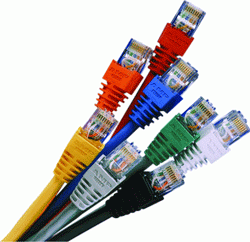Ethernet, first introduced in the 1980s as a leading Local Area Network (LAN) protocol, is gaining traction as the preferred choice for Metropolitan Area Networks (MANs) and Wide Area Networks (WANs). This trend suggests a future dominated by Ethernet for network connectivity. What’s fueling this shift, and how can your business benefit?
Ethernet’s staying power in the LAN realm, both presently and in the future, is rooted in its cost-effectiveness and widespread availability. Almost all networking equipment comes equipped with standard copper or fiber Ethernet ports, the most common being the familiar RJ-45 connector. This universal compatibility makes internal network connections seamless.
The challenge arises when you need to extend your network beyond your building or campus. While local contractors might offer interconnections within limited areas like office parks, and technologies like optical line of sight or microwave wireless transmissions offer some range extension, connecting to the internet or building a private network across larger distances necessitates partnering with a telecom carrier.
Initially, these carriers were local telephone companies. Today, these Incumbent Local Exchange Carriers (ILECs) provide services far beyond traditional telephone lines. They possess extensive copper and fiber optic cable networks, relying on specialized protocols developed for voice calls. Copper data transmissions utilize T-Carrier technologies like T1 or T3, while fiber optic transmissions utilize Synchronous Optical NETwork (SONET) standards like OC-3, OC-12, and OC-48.
Bridging the gap between an Ethernet-based network and a T-Carrier or SONET carrier network requires a protocol converter, often a module for your router. This device translates the signals and timing of one protocol to another, enabling data exchange.
While this conversion process has been effective for many years, why change it? The answer lies in the drive for efficiency, new service opportunities, and cost savings.
The emergence of competitive carriers has disrupted the traditional telecommunications landscape. These new carriers, unburdened by legacy telephone company standards, have embraced IP networking for their fiber optic networks, both regionally and nationally. Given that both your network and theirs utilize Ethernet, direct interconnection via Ethernet becomes a logical solution.
The standardization of Carrier Ethernet by the Metro Ethernet Forum (MEF) has paved the way for seamless network traffic handoffs between businesses and carriers, and among carriers themselves, all within the Ethernet protocol. Eliminating the need for protocol conversion enhances efficiency and, importantly, enables services not possible with older telco networks, such as E-Line (Ethernet Line) and E-LAN (Ethernet LAN). E-Line facilitates point-to-point connections between two locations, while E-LAN supports connections between multiple locations in a mesh network.
Maintaining an all-Ethernet infrastructure allows for the interconnection of LANs across multiple sites at the layer 2 level using Ethernet switches. This effectively merges separate LANs into a single, larger corporate network.
Carrier Ethernet offers scalability advantages over traditional telco protocols. When installing a port, you choose a maximum bandwidth (e.g., 100 Mbps, 1000 Mbps, 10 GigE) but can initially utilize a fraction of that capacity and scale up as needed, often with a simple call to your provider. This eliminates equipment swaps and enables rapid bandwidth adjustments within hours or days.
Lastly, Carrier Ethernet boasts significant cost advantages over bonded T1, T3 (DS3) bandwidth, and SONET services. On a per-Mbps basis, Ethernet can cost half as much as older technologies, potentially leading to telecom cost savings or increased bandwidth for the same budget.
To determine if long-range Ethernet suits your needs, it’s wise to obtain quotes for both traditional bandwidth and Carrier Ethernet services. This will allow you to compare costs and features effectively.
 ](
](
